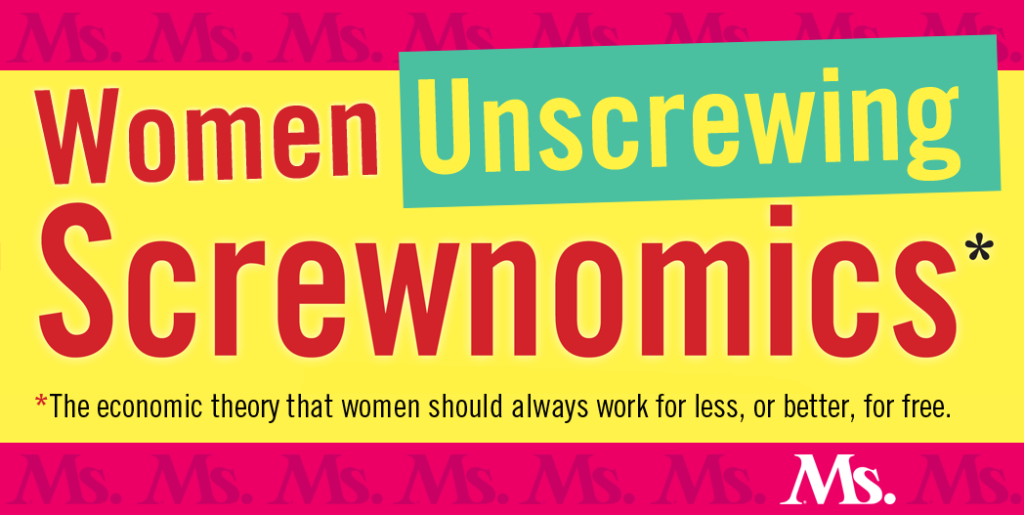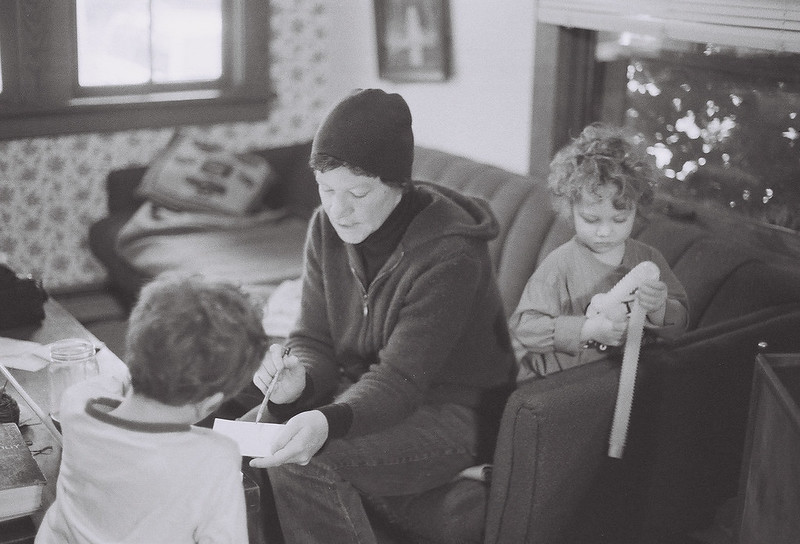“Nobody asked us if we’d homeschool our kids. … We did it for our country. So we need some bold action from our country.”

It’s time to talk about women’s economics with attitude. It’s time to laugh at what is often absurd and call out what is dangerous. By focusing on voices not typically part of mainstream man-to-man economic discourse, Women Unscrewing Screwnomics will bring you news of hopeful and practical changes and celebrate an economy waged as life—not as war.
On January 26, the game-changing nonprofit, Girls Who Code, put a full-page ad in The New York Times calling for President Biden to create a Marshall Plan for Moms. Fifty high-profile women activists and celebrities, including the leaders of the Women’s March and the MeToo movement, added their voices to the choir, led by CEO of Girls Who Code, Reshma Saujani. Their online petition, which they urge you to sign, reads:
“Moms are the bedrock of society. And we’re tired of working for free. It’s time to put a dollar figure on our labor.”
On Feb. 25, a parallel letter ran in the Washington Post calling on Congress to support the Marshall Plan for Moms—this time signed by 50 men, including basketball superstar Steph Curry, actors Colin Farrell and Don Cheadle, and philanthropist Craig Newmark.
“When more than 30 years of progress for women in the work force can be erased in nine months, the underlying system is broken,” the letter, displayed as a full-page ad, reads. “It’s time to create a new structure that works for women, that respects and values their labor. Men have a role to play.”
Like the original Marshall Plan of 1948 that rebuilt Europe post WWII, the signers are calling for a financial investment in rebuilding women’s lives.
Alleviating the Massive Losses to Women Workers

COVID-19 has decimated women’s paychecks and careers. In September alone, four times as many women as men lost jobs. Two million women have had to leave the work force, and millions more have been forced to cut back on their hours. Many are stressed and exhausted from juggling their paid jobs with their work at home as moms, supervising children’s schooling, taking care of younger children in the absence of child care and caring for parents during the pandemic.
The impact takes a personal toll, but it also diminished the nation’s work force—at the beginning of 2020, women made up the majority of the nation’s workers.
The petition demands a task force; they want a short-term monthly payment to moms, depending on her needs and resources; but more importantly, they want Congress to pass “long overdue policies like paid family leave, affordable child care and pay equity.”
“We Have To Live in a World That Is, Not What We Want It To Be”
Batting down any hesitation to identify moms as the workers supplying the majority of unpaid labor at home, Saujani explained, “We have to live in a world that is, not what we want it to be. Moms still do most of the work at home; we all know that they do. Our plan is a focus on moms; it’s not an exclusion.”
She said while there has been some state legislation for providing workers sick leave, moms and dads had to really show up to get this actually passed. “That’s what we need now. We have a new sense of urgency we haven’t had before. There’s a populist mom-rage that many are feeling.”
Saujauni said she also sometimes hears the comment that motherhood is a choice—as if women were to blame for this problem. “We didn’t choose for schools to shut down. Not all things that happen to moms are her choice.”
Saujani points out that when President Obama inherited the 2008 financial crisis, it took eight years before the economy began to recover. By contrast, she said: “It took us nine months for women to lose thirty years of progress. Everyone has seen the cracks in our safety net—and that women are bearing the brunt. We have an opportunity to build it back better with policies like paid family leave, affordable child care and pay equity.”
She’s aware this requires a big cultural change. “Too many of our partners have watched moms at home and didn’t really change their behavior. We need to be having honest conversations at home.
“And what about the work place? We’ve had to hide our children. The private sector should be encouraged to take the lead in ensuring child care for their employees. We want them to say, ‘We gotta hire a mom, ‘cause moms can handle this’—no more motherhood penalty! You shouldn’t have to choose between having a child and having a job. We need a work place culture that allows for both.”
(She didn’t say, “You know, like men expect to,” but there it is—moms again.)
“America doesn’t work without our mothers,” she said. “This pandemic has shown us that. Nobody asked us if we’d homeschool our kids—and we did it, we did it for our country. So we need some bold action from our country.
“Before COVID, many moms were hanging on by a thread. Without a safety net, their situation was already shaky. Child poverty is a huge issue. Women of color have been especially hard hit. This is a unique moment to call attention to all that. We have an opportunity for retraining, for stimulus that will make a huge difference.
“We’re saying, ‘Let’s talk about the pandemic and what it has revealed.’ What is wrong with the structure of our society that it is affecting mothers more than any other demographic? We’re in a recession because of it and we need bold ideas.”
“Never before have women had such political power as we have now. We should ask for what we need. This is a wake-up call,” Saujani said.
A History of Mother’s Allowances
Paying mothers is not a new idea. In fact, after WWI, a well-born British suffragist named Eleanor Rathbone, wrote a book based on her research of families headed by women whose husbands had gone off to war. Vulnerable whenever a spouse failed to send home his check, war mothers struggled to survive.
As Rathbone learned, even when returned home, a husband might not share his small paycheck. Mothers needed an income separate from her husband’s good will if they were to supply England with healthy future citizens and a work force.
She began to push for, and ultimately won, post-WWII, what Parliament called a Mother’s Allowance, a universal per child government check sent direct to every mom in England, regardless of income—a bit like the universal basic income that so many are talking about now, though never in connection with mothers’ tangible household work.
Meanwhile in the U.S., Americans begrudged mothers, unless they waxed ecstatic over new frost-free refrigerators. We had Aid to Families with Dependent Children (AFDC), a program name that neatly erased moms from the picture. Those who headed families in poverty, who needed AFDC, were called lazy, immoral or welfare queens, despite their intelligent and active organizing.
They formed the National Welfare Rights Organization in 1966, later renamed a union, arguing that the work of managing a functional home, supplying meals and raising up children deserved paychecks, not handouts.
In a monied economy still largely run by men who never cook dinners or think to change the toilet paper roll, any work on the home front will remain invisible unless, as Saujani urges, we value the valor so many moms show every day.
Editor’s Note: The title of this article was inspired by sociologist Jessica Calarco’s quote “Other countries have social safety nets. The U.S. has women.”
Up next:





